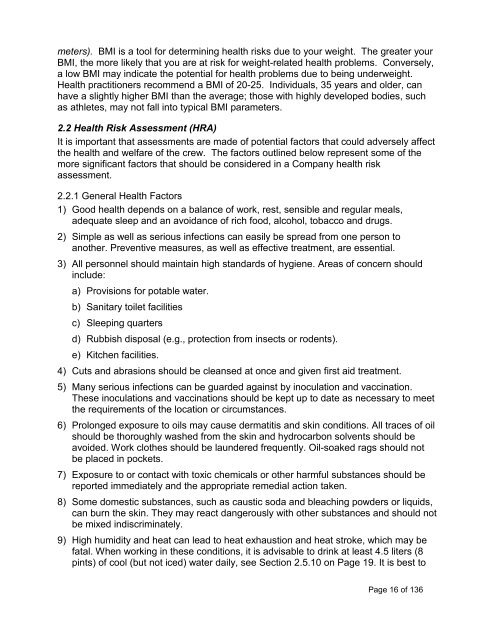IAGC LAND GEOPHYSICAL SAFETY MANUAL Edition 9 ... - CGISS
IAGC LAND GEOPHYSICAL SAFETY MANUAL Edition 9 ... - CGISS
IAGC LAND GEOPHYSICAL SAFETY MANUAL Edition 9 ... - CGISS
- No tags were found...
Create successful ePaper yourself
Turn your PDF publications into a flip-book with our unique Google optimized e-Paper software.
meters). BMI is a tool for determining health risks due to your weight. The greater yourBMI, the more likely that you are at risk for weight-related health problems. Conversely,a low BMI may indicate the potential for health problems due to being underweight.Health practitioners recommend a BMI of 20-25. Individuals, 35 years and older, canhave a slightly higher BMI than the average; those with highly developed bodies, suchas athletes, may not fall into typical BMI parameters.2.2 Health Risk Assessment (HRA)It is important that assessments are made of potential factors that could adversely affectthe health and welfare of the crew. The factors outlined below represent some of themore significant factors that should be considered in a Company health riskassessment.2.2.1 General Health Factors1) Good health depends on a balance of work, rest, sensible and regular meals,adequate sleep and an avoidance of rich food, alcohol, tobacco and drugs.2) Simple as well as serious infections can easily be spread from one person toanother. Preventive measures, as well as effective treatment, are essential.3) All personnel should maintain high standards of hygiene. Areas of concern shouldinclude:a) Provisions for potable water.b) Sanitary toilet facilitiesc) Sleeping quartersd) Rubbish disposal (e.g., protection from insects or rodents).e) Kitchen facilities.4) Cuts and abrasions should be cleansed at once and given first aid treatment.5) Many serious infections can be guarded against by inoculation and vaccination.These inoculations and vaccinations should be kept up to date as necessary to meetthe requirements of the location or circumstances.6) Prolonged exposure to oils may cause dermatitis and skin conditions. All traces of oilshould be thoroughly washed from the skin and hydrocarbon solvents should beavoided. Work clothes should be laundered frequently. Oil-soaked rags should notbe placed in pockets.7) Exposure to or contact with toxic chemicals or other harmful substances should bereported immediately and the appropriate remedial action taken.8) Some domestic substances, such as caustic soda and bleaching powders or liquids,can burn the skin. They may react dangerously with other substances and should notbe mixed indiscriminately.9) High humidity and heat can lead to heat exhaustion and heat stroke, which may befatal. When working in these conditions, it is advisable to drink at least 4.5 liters (8pints) of cool (but not iced) water daily, see Section 2.5.10 on Page 19. It is best toPage 16 of 136
















